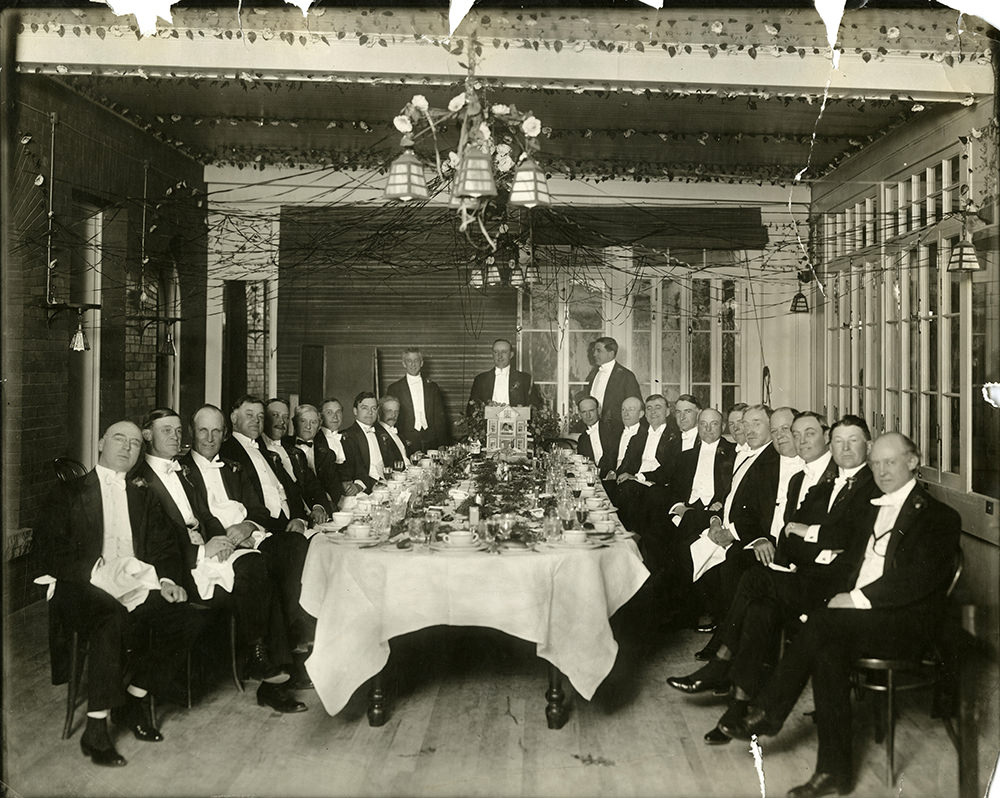Reno’s first address has undergone impressive transformations in its 150-plus years.
It sits there grandly, arguably at the most prestigious and prominent location in Reno. For more than a century, the Riverside Hotel has fed, housed, and entertained locals and visitors alike. It has existed through several versions of itself and the adjacent Virginia Street Bridge. Deals were struck there with handshakes, and its daily activities were fodder for the gossip columnists.
Glamorous address
The hotel’s site often is called Reno’s first address. From 1860, the spot was home to a succession of modest structures that provided food and shelter. The situation changed radically when Harry Gosse arrived on the scene in 1906. The small-frame hotel was transformed into something stunning and Châteauesque. On May 3, 1907, the Reno Evening Gazette described the newly finished barroom as “among the very best in Nevada.” Its furnishings were sumptuous, and management touted the large and modern kitchen and dining room. “The Verandah, which will be a feature of the summer accommodations, will be enclosed in glass and give a beautiful view of the Truckee,” stated the Gazette. “When ready it will be among the finest on the Pacific coast.”
The year 1915 was a big one for the Riverside. An ad read, “You and your family and friends are invited to attend the New Year’s dinner … $1.90 per plate. It can’t be beat.” Its Lanai, previously known as the Verandah, also was touted as “Reno’s most popular café overlooking the Truckee River with music and dancing.” To draw more attention, the Lanai held a modern dance recital, direct from the Panama-Pacific International Exposition. By 1917, the hotel’s new tea and supper room opened and it included live music. In a forward-looking move, the Riverside offered reservations by phone.
Rising from the ashes
Despite its imposing brick structure, the Riverside was destroyed by fire on March 15, 1922. The Nevada State Journal reported that there were “jagged remnants of walls and gaunt chimneys where revelry long has reigned.” Gosse lacked the finances to rebuild. It fell to George Wingfield, Reno’s most powerful man at the time, to acquire it and commission well-known local architect Frederic DeLongchamps to design the building still seen today. The six-story brick building — the tallest in Nevada at the time — featured Gothic Revival touches and terra cotta trim. The hotel reopened in 1927, and it flourished for three decades.
Starting in 1935, Wingfield leased out the food and gaming operations to his longtime business partner Nick Abelman and associates. This was the heyday of Reno’s fame as a divorce capital, and the hotel attracted such famous guests as Gloria Vanderbilt and Clare Boothe Luce. Reporters from the Associated Press, United Press, and others camped out in the hotel lobby, spotting celebrities and looking for exclusive stories. The rich and famous created a posh atmosphere, complete with the hotel’s supper club and dancing. Soon, the Riverside was Reno’s most popular hotel.
Change arrived in 1949, when Abelman sold his interest to businessman Mert Wertheimer. Facing competition from the new Mapes hotel, the Riverside brought in major entertainers such as Sophie Tucker, Joe E. Lewis, Louis Armstrong, and Jimmy Durante. In anticipation of the sports bars of today, in 1954, the Riverside hosted guests to “watch the fights on television on the Pabst Blue Ribbon Telecast,” as newspaper ads read that spring. The gossip columns, especially one entitled “Day and Nite” in the Reno Evening Gazette, were peppered with tidbits about the hotel’s social life and socialites.
The Corner Bar became a popular spot for Reno’s movers and shakers. Red brocade wallpaper, a horseshoe bar, and a piano player who took requests made this the power spot for lawyers, gamblers, entertainers, and politicians.
The Riverside changed ownership several times, falling on hard times, and eventually closing in 1986. But just as a new hotel had risen from the ashes in 1922, the Riverside was once again reinvented. The building faced demolition in 1997, until Sierra Arts partnered with Artspace, a Minneapolis-based developer of historic properties, to convert the hotel rooms into artist lofts. The Riverside now is listed on the National Register of Historic Places. The riverfront has never looked better, with a new bridge outside its doors as well as the Wild River Grille, a popular watering hole and restaurant that brings back a bit of glamour and a lot of history to this important address.
Sharon Honig-Bear was the longtime restaurant writer for the Reno Gazette-Journal. She relishes Reno history and is a tour leader with the Historic Reno Preservation Society. You can reach her with comments and story suggestions at Sharonbear@sbcglobal.net.


